Field Measurements and Numerical Simulations of Temperature and Moisture in Highway Engineering Using a Frequency Domain Reflectometry Sensor
Abstract
:1. Introduction
2. Field Measurement Based on Agricultural-Purpose FDR Sensor
2.1. Basic Composition and Testing Principle of FDR Sensor
2.1.1. Basic Composition
2.1.2. Testing Principle
2.2. Embedding of an Agricultural-Purpose FDR Sensor
2.2.1. Project Overview
2.2.2. Embedding Method and Process
- (1)
- Embedding FDR sensor in old subgrade: drill horizontally to the predetermined depth at the side slope of the old subgrade with a drilling machine (borehole diameter: 11.0 cm); install the FDR sensor on one end of the PVC tube (diameter: about 5 cm), and push it to the bottom of the borehole from the other end of the PVC tube to make it completely and closely inserted into soil horizontally (in the old subgrade).
- (2)
- Embedding FDR probes in new subgrade: at the preset subgrade elevation, compact and level the subgrade surface and excavate a pit (L × W × D: 40 cm × 30 cm × 20 cm) manually at a certain interval; then closely insert the probe into soil along the bottom of the pit in a lateral direction (the inserting direction is vertical to the longitudinal direction of the subgrade); last, excavate a small groove along the cross section of the newly-filled subgrade (W: 10 cm; D: 20 cm; L: 750 cm (viz. the width of the entire newly-filled subgrade)) to embed the sensor wire into the groove and lead it to the outer side of the subgrade slope. The embedding flow diagram and field embedding sketch for FDR sensors are shown in Figure 2 and Figure 3, respectively.
2.3. Data Acquisition and Transmission
3. Numerical Simulation Based on Measured Data
3.1. Theoretical Model and Boundary Conditions
3.1.1. Numerical Model
3.1.2. Calculation Equation for Flow Boundary Condition
3.1.3. Temperature Boundary Conditions
3.2. Geometric Model for Finite Element Calculation
3.2.1. Measured Climatic Parameters
3.2.2. Other Parameters
3.3. Calibration for the Finite Elements
4. Measured Results and Analyses
4.1. Temperature Observations
4.2. Moisture Content Observations
4.3. Comparative Analysis of Field Measurements and Numerical Simulations
4.3.1. Comparative Analysis of Temperature
4.3.2. Comparative Analysis of Moisture Content
5. Conclusions
- (1)
- FDR sensors were applied to the subgrade in a highway reconstruction project for the first time, and the embedding method and process of the sensors are illustrated. During a monitoring period of over two years, all embedded sensors present reasonable performance for monitoring the temperature and moisture inside the subgrade soil. This implies that the embedding method and process proposed in this paper are reasonable and also indicates that agricultural-purpose FDR sensors are applicable to the subgrade in highway reconstruction and extension projects.
- (2)
- By means of the small weather station built in the field and the GPRS module performing wireless transmission, the real-time data monitored by FDR sensors can be acquired remotely. Thus, the labor cost can be largely reduced and analysis of real-time data monitored is accessible, thereby enhancing timely and effective evaluation of subgrade performance.
- (3)
- Comparison between the measured results by FDR sensors and computed results from numerical simulation also demonstrated that the FDR sensor can effectively reflect the temperature and moisture changes inside subgrades, especially at the junction between the old and new subgrades, the measured values are more reasonable and effective than the calculated values, and can reflect the temperature and moisture changes caused by the climatic environment more accurately.
- (4)
- The paper provides a new method and idea for highway researchers to monitor long-term changes of the temperature and moisture inside the subgrade, and further inspect its long-time performance. This method can be also extended to railway embankments, prevention and treatment of slopes foundation engineering and other civil engineering projects which are affected by soil moisture content and temperature.
Acknowledgments
Author Contributions
Conflicts of Interest
Appendix A
| Project | Indicators | Note |
|---|---|---|
| Measurement parameters | Measured medium volumes of moisture content | - |
| Application objects | Soils, other solids or powdered medium | - |
| Accuracy of measurement | ±0.5% vol ((if the soil was calibrated) ±2.0% vol (direct measurement) | Range of 0~saturated water content |
| Resolution ratio | ±0.1% vol | - |
| Deviation caused by Salinity | Not more than 3.5% vol (0 saturated moisture content) | FDR can be used after calibrating |
| Power consumption | 22 mA (characteristic value) | - |
| Supply voltage | 9–12 V | - |
| Output signal | 0–1200 mV | - |
| Measurement of volume | 60 mm (length) × 30 mm (diameter) | - |
| Work environment | −30 °C~+50 °C | - |
Appendix B
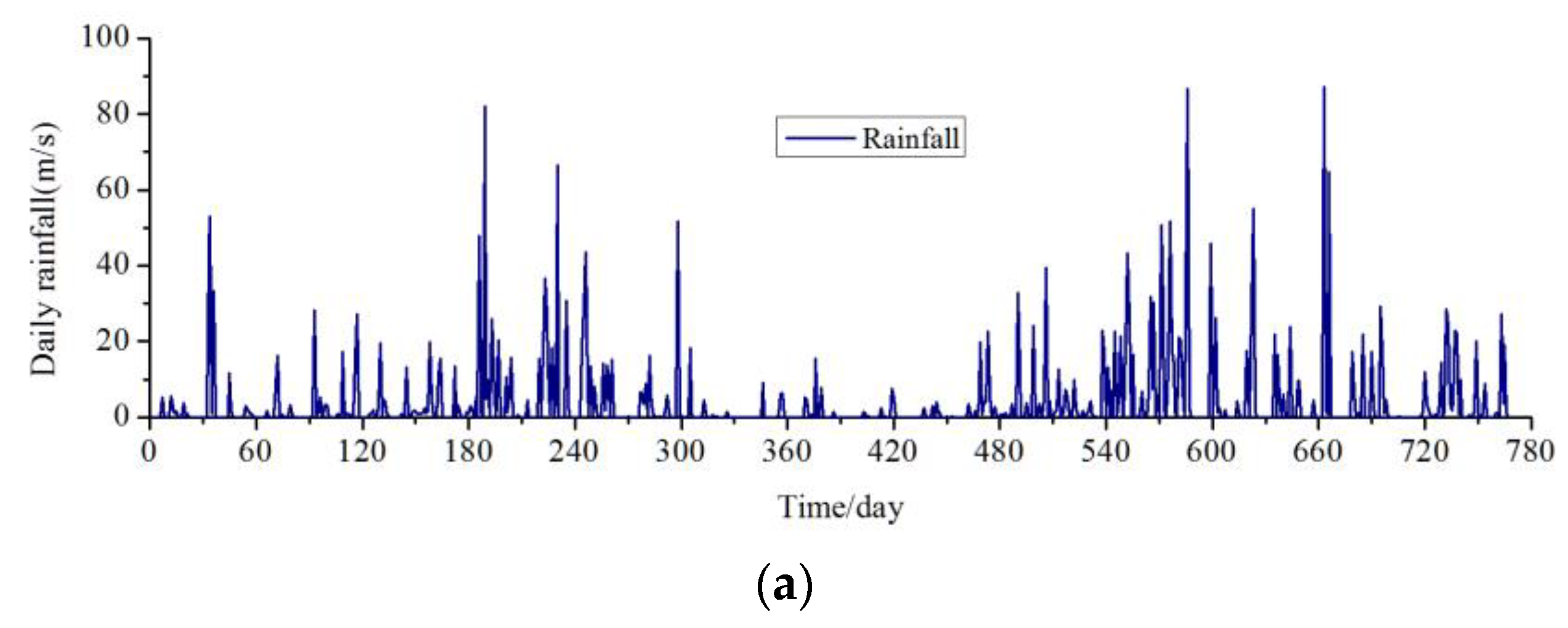
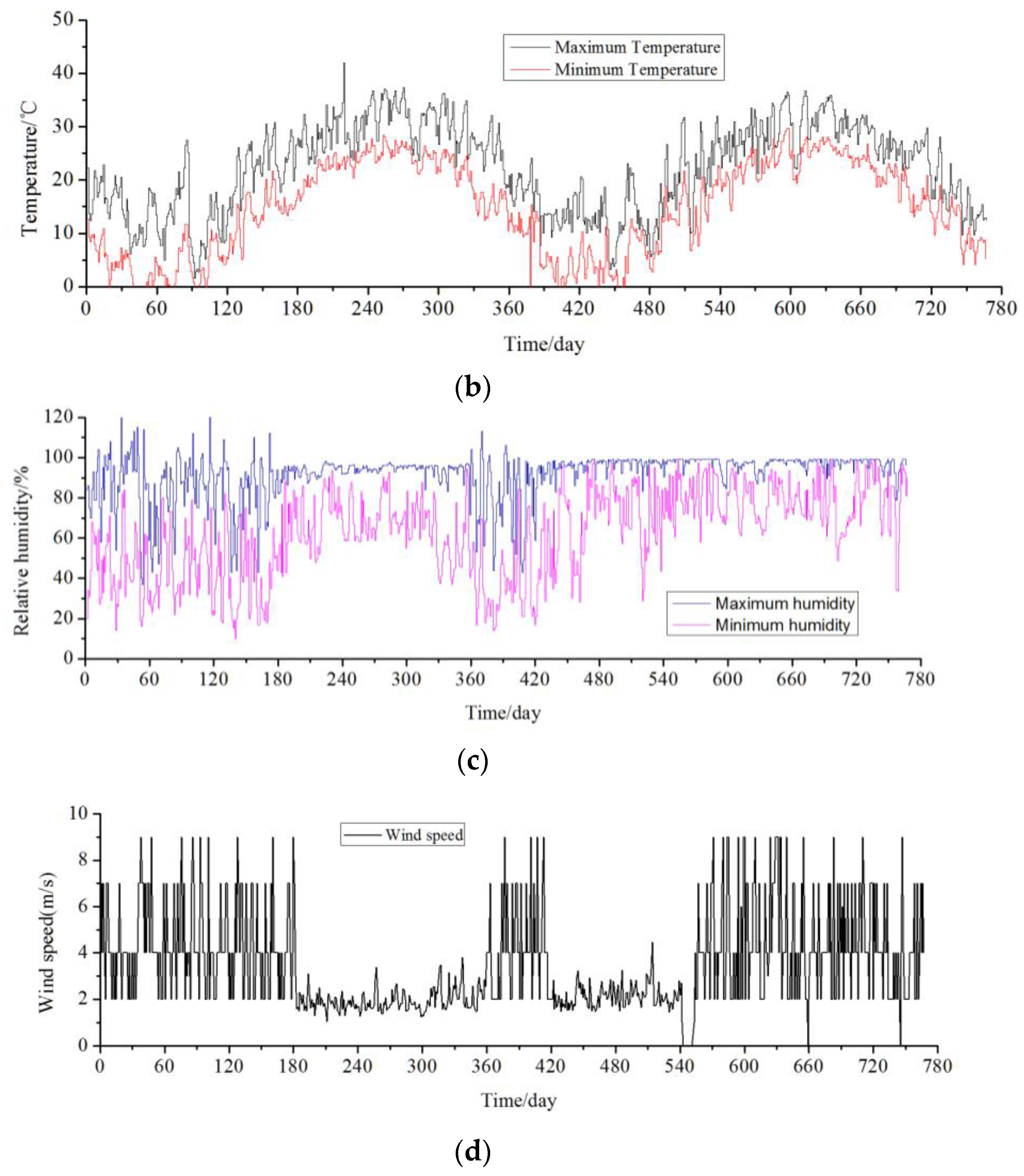
References
- AASHTO. Standard Method of Test for Determining the Resilient Modulus of Soils and Aggregate Materials; American Association of State and Highway Transportation Officials: Washington, DC, USA, 2007. [Google Scholar]
- Mancuso, C.; Vassallo, R.; d’Onofrio, A. Small strain behavior of a silty sand in controlled-suction resonant column torsional shear tests. Can. Geotech. J. 2002, 39, 22–31. [Google Scholar] [CrossRef]
- Ng, C.W.W.; Zhou, C.; Yuan, Q.; Xu, J. Resilient modulus of unsaturated subgrade soil: Experimental and theoretical investigations. Can. Geotech. J. 2013, 50, 223–232. [Google Scholar] [CrossRef]
- Zhou, C.; Xu, J.; Ng, C. Effects of temperature and suction on secant shear modulus of unsaturated soil. Géotech. Lett. 2015, 5, 123–128. [Google Scholar] [CrossRef]
- Coccia, C.J.; McCartney, J.S. Impact of heat exchange on the thermo-hydro-mechanical response of reinforced embankments. In Geo-Congress 2013: Stability and Performance of Slopes and Embankments III; ASCE: San Diego, CA, USA, 2013; pp. 343–352. [Google Scholar]
- Wen, Z.; Zhang, M.; Ma, W.; Wu, Q.; Niu, F.; Yu, Q.; Fan, Z.; Sun, Z. Thermal–moisture dynamics of embankments with asphalt pavement in permafrost regions of central tibetan plateau. Eur. J. Environ. Civ. Eng. 2015, 19, 387–399. [Google Scholar] [CrossRef]
- Zhang, J.; Jiang, Q.; Zhang, Y.; Dai, L.; Wu, H. Nondestructive measurement of water content and moisture migration of unsaturated red clays in South China. Adv. Mater. Sci. Eng. 2015, 1, 1–7. [Google Scholar] [CrossRef]
- Liu, W.; Qu, S.; Nie, Z.; Zhang, J. Effects of Density and Moisture Variation on Dynamic Deformation Properties of Compacted Lateritic Soil. Adv. Mater. Sci. Eng. 2016, 2016, 1–11. [Google Scholar] [CrossRef]
- Zhang, J.; Dai, L.; Zheng, J.; Wu, H. Reflective Crack Propagation and Control in Asphalt Pavement Widening. J. Test. Eval. 2015, 44, 838–846. [Google Scholar] [CrossRef]
- Thomas, H.; Zhou, Z. A comparison of field measured and numerically simulated seasonal ground movement in unsaturated clay. Int. J. Numer. Anal. Methods Geomech. 1995, 19, 249–265. [Google Scholar] [CrossRef]
- Zhang, D.-W.; Liu, S.-Y. Numerical analysis of interaction between old and newembankment in widening of freeway on soft ground. China J. Highw. Transp. 2006, 19, 7–12. [Google Scholar]
- Cui, Y.-J.; Gao, Y.; Ferber, V. Simulating the water content and temperature changes in an experimental embankment using meteorological data. Eng. Geol. 2010, 114, 456–471. [Google Scholar] [CrossRef]
- Que, Y.; Chen, J. Numerical simulation for the seasonal change of the temperature and humidity field of embankment in moist heat areas. In Applied Mechanics and Materials; Trans Tech Publisher: Zurich, Switzerland, 2014; pp. 1295–1300. [Google Scholar]
- Hanson, J.L.; Liu, W.-L.; Yesiller, N. Analytical and numerical methodology for modeling temperatures in landfills. Civ. Environ. Eng. 2008, 135, 24–31. [Google Scholar]
- Hilhorst, M.A.; Groenwold, J.; de Groot, J.F. Water content measurements in soil and rockwool substrates: Dielectric sensors for automatic in situ measurements. In I International Workshop on Sensors in Horticulture; International Society for Horticultural Science: Leuven, Belgium, 1992; pp. 209–218. [Google Scholar]
- Hilhorst, M.A.; Balendonck, J.; Kampers, F.W. A broad-bandwidth mixed analog/digital integrated circuit for the measurement of complex impedance. IEEE J. Solid State Circuits 1993, 28, 764–769. [Google Scholar] [CrossRef]
- Leib, B.G.; Jabro, J.D.; Matthews, G.R. Field evaluation and performance comparison of soil moisture sensors. Soil Sci. 2003, 168, 396–408. [Google Scholar] [CrossRef]
- Tejero, I.G.; Durán Zuazo, V.H.; Jiménez Bocanegra, J.A.; Torres, F.P.; Muriel Fernández, J.L. Impact of direct drilling and conventional tillage on seasonal changes of soil water content in chromic haploxerert (South-West Spain). Arch. Agron. Soil Sci. 2013, 59, 393–409. [Google Scholar] [CrossRef]
- Stacheder, M.; Koeniger, F.; Schuhmann, R. New dielectric sensors and sensing techniques for soil and snow moisture measurements. Sensors 2009, 9, 2951–2967. [Google Scholar] [CrossRef] [PubMed]
- Ye, L.; Xue, L.; Zhang, G.; Chen, H.; Shi, L.; Wu, Z.; Yu, G.; Wang, Y.; Niu, S.; Ye, J.; et al. FDR Soil Moisture Sensor for Environmental Testing and Evaluation. Phys. Procedia 2012, 25, 1523–1527. [Google Scholar]
- Choi, E.-Y.; Yoon, Y.-H.; Choi, K.-Y.; Lee, Y.-B. Environmentally sustainable production of tomato in a coir substrate hydroponic system using a frequency domain reflectometry sensor. Hortic. Environ. Biotechnol. 2015, 2, 167–177. [Google Scholar] [CrossRef]
- Skierucha, W.; Wilczek, A. A FDR Sensor for Measuring Complex Soil Dielectric Permittivity in the 10–500 MHz Frequency Range. Sensors 2010, 10, 3314–3329. [Google Scholar] [CrossRef] [PubMed]
- Wilczek, A.; Szypłowska, A.; Skierucha, W.; Cieśla, J.; Pichler, V.; Janik, J. Determination of Soil Pore Water Salinity Using an FDR Sensor Working at Various Frequencies up to 500 MHz. Sensors 2012, 12, 10890–10905. [Google Scholar] [CrossRef] [PubMed]
- Lukangu, G.; Savage, M.J.; Johnston, M.A. Use of sub-hourly soil water content measuredwith a frequency-domain reflectometer to schedule irrigation of cabbages. Irrig. Sci. 1999, 19, 7–13. [Google Scholar] [CrossRef]
- Girón, I.F.; Corell, M.; Galindo, A.; Torrecillas, E.; Morales, D.; Dell’Amico, J.; Torrecillas, A.; Moreno, F.; Moriana, A. Changes in the physiological response between leaves and fruitsduring a moderate water stress in table olive trees. Agric. Water Manag. 2015, 148, 280–286. [Google Scholar] [CrossRef]
- Chiaradia, E.A.; Facchi, A.; Masseroni, D.; Ferrari, D.; Bischetti, G.B.; Gharsallah, O.; de Maria, S.C.; Rienzner, M.; Naldi, Z.; Romani, M.; et al. An integrated, multisensor system for the continuous monitoring of water dynamics in rice fields under different irrigation regimes. Environ. Monit. Assess. 2015, 187, 1–17. [Google Scholar] [CrossRef] [PubMed]
- Inoue, M.; Ahmed, B.O.; Saito, T.; Irshad, M. Comparison of twelve dielectric moisture probes for soil water measurement under saline conditions. Am. J. Environ. Sci. 2008, 4, 367–372. [Google Scholar] [CrossRef]
- Kizito, F.; Campbell, C.; Campbell, G.; Cobos, D.; Teare, B.; Carter, B.; Hopmans, J. Frequency, electrical conductivity and temperature analysis of a low-cost capacitance soil moisture sensor. J. Hydrol. 2008, 352, 367–378. [Google Scholar] [CrossRef]
- Tran, A.P.; Bogaert, P.; Wiaux, F.; Vanclooster, M.; Lambot, S. High-resolution space–time quantification of soil moisture along a hillslope using joint analysis of ground penetrating radar and frequency domain reflectometry data. J. Hydrol. 2015, 523, 252–261. [Google Scholar] [CrossRef]
- Zheng, J.; Zhang, R. Prediction and application of equilibrium water content of expansive soil subgrade. In IACGE 2013: Challenges and Recent Advances in Geotechnical and Seismic Research and Practices; ASCE: San Diego, CA, USA, 2013; pp. 754–761. [Google Scholar]
- Philip, J.; de Vries, D. Moisture movement in porous materials under temperature gradients. Trans. Am. Geophys. Union 1957, 38, 222–232. [Google Scholar] [CrossRef]
- Edlefsen, N.E.; Anderson, A.B. Thermodynamics of Soil Moisture; University of California: Oakland, CA, USA, 1943. [Google Scholar]
- Wilson, G.W.; Fredlund, D.; Barbour, S. Coupled soil-atmosphere modelling for soil evaporation. Can. Geotech. J. 1994, 31, 151–161. [Google Scholar] [CrossRef]
- Wilson, G.W.; Fredlund, D.; Barbour, S. The effect of soil suction on evaporative fluxes from soil surfaces. Can. Geotech. J. 1997, 34, 145–155. [Google Scholar] [CrossRef]
- Fredlund, D.G.; Xing, A. Equations for the soil-water characteristic curve. Can. Geotech. J. 1994, 31, 521–532. [Google Scholar] [CrossRef]

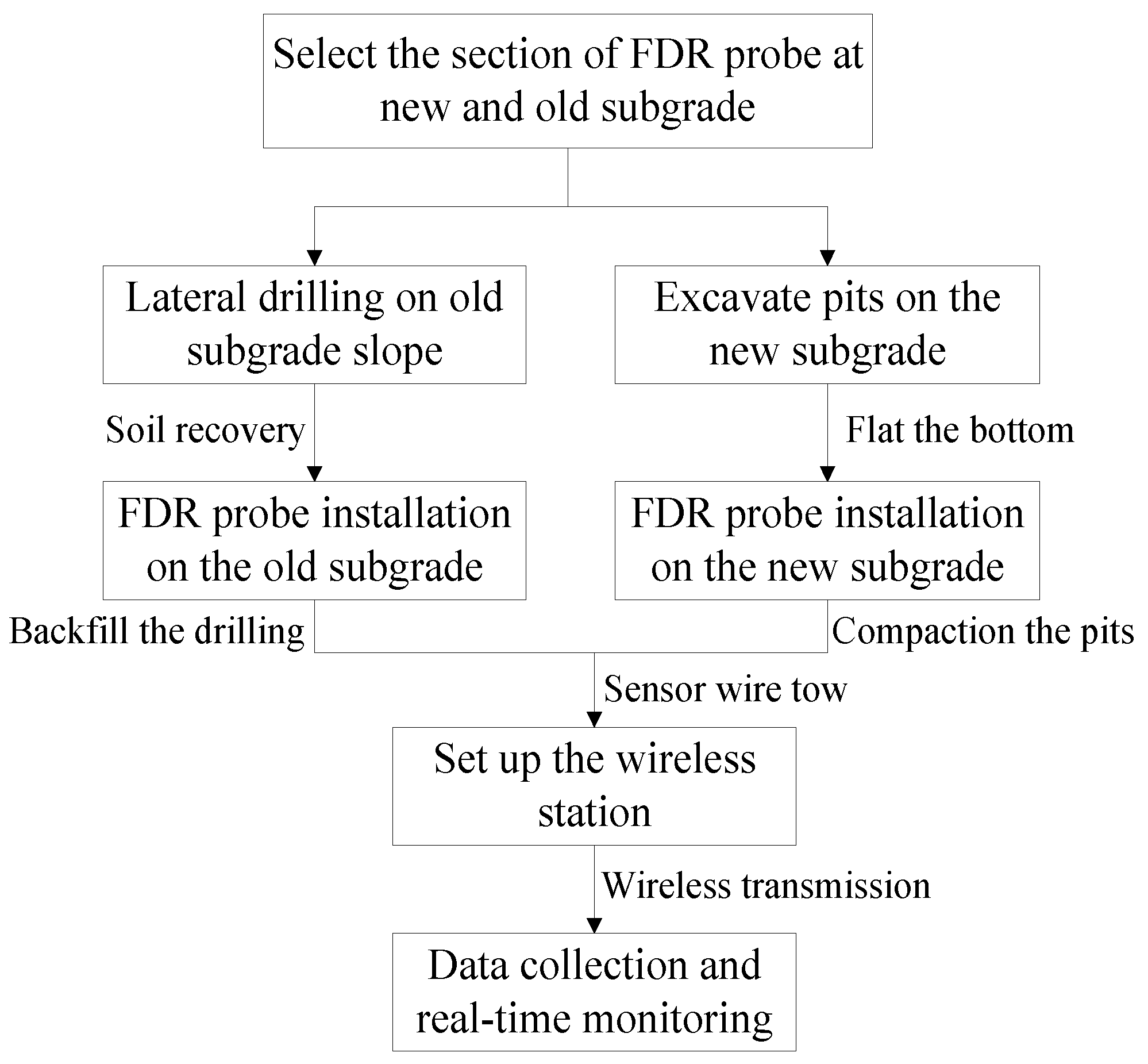
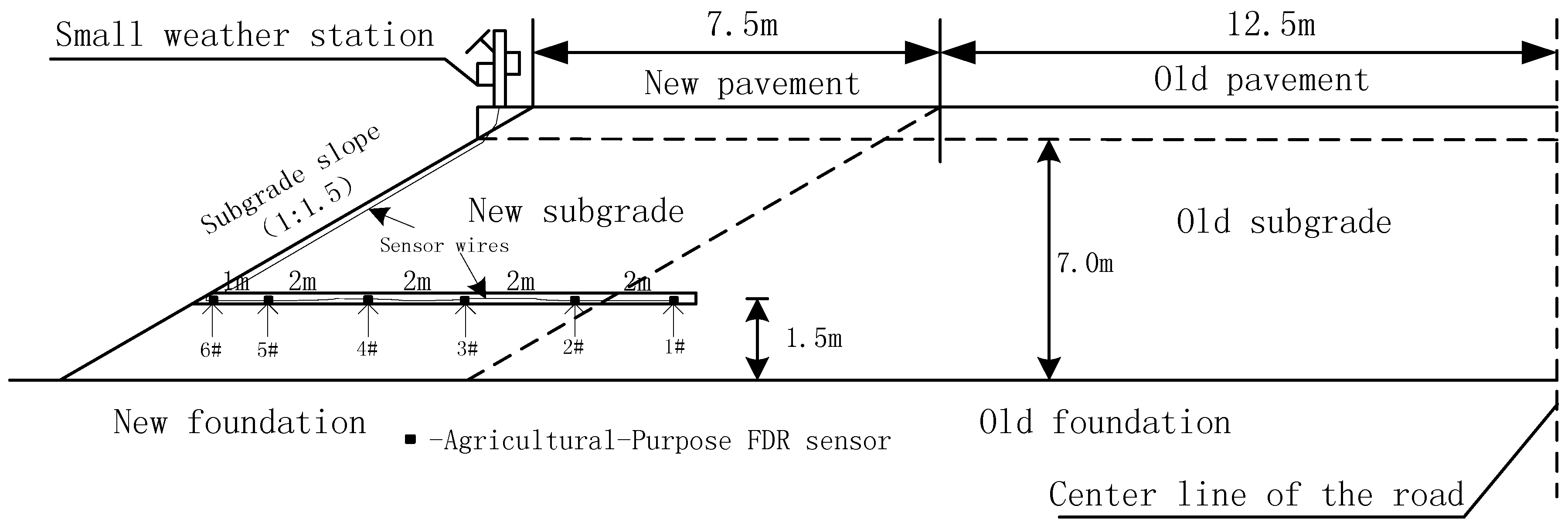
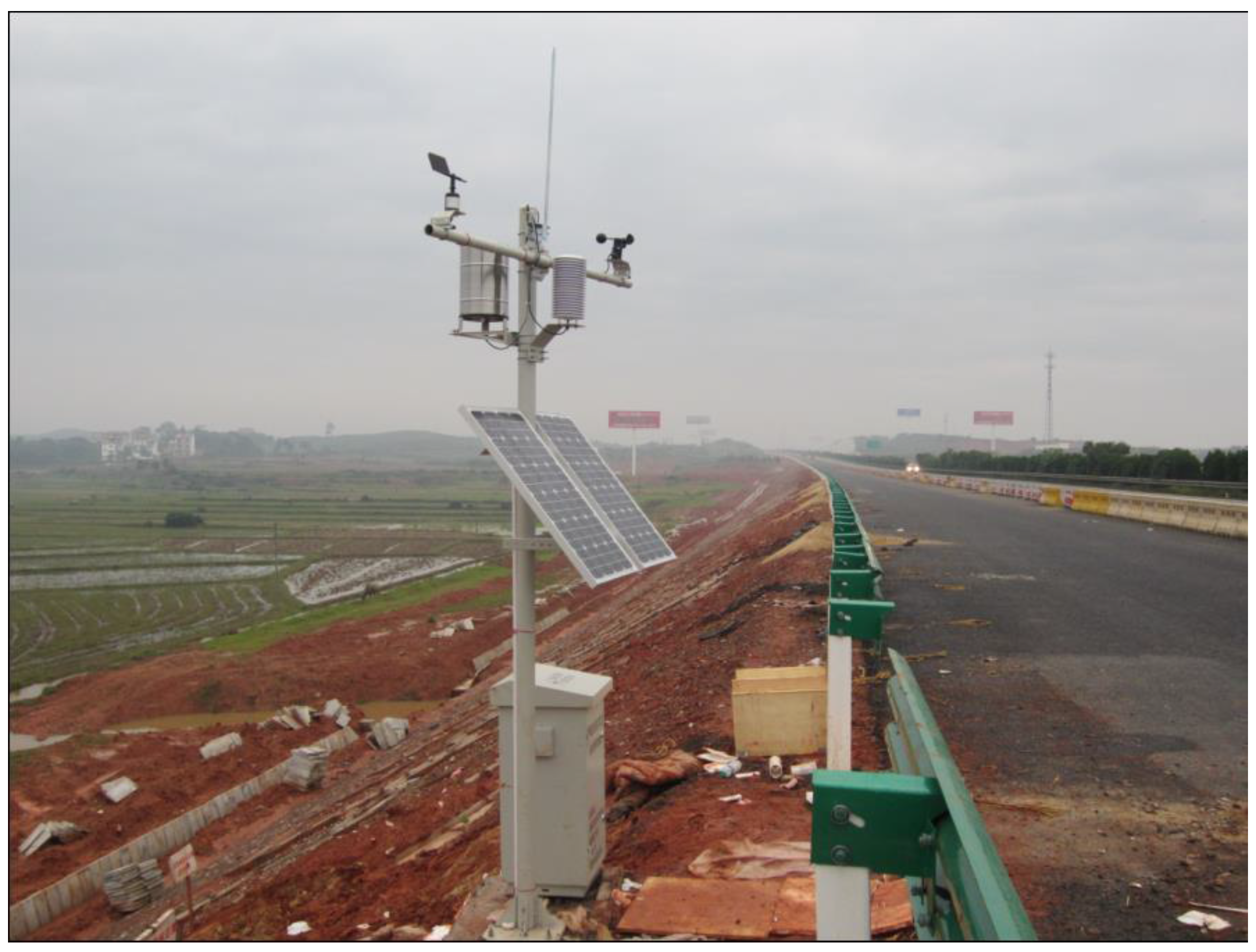
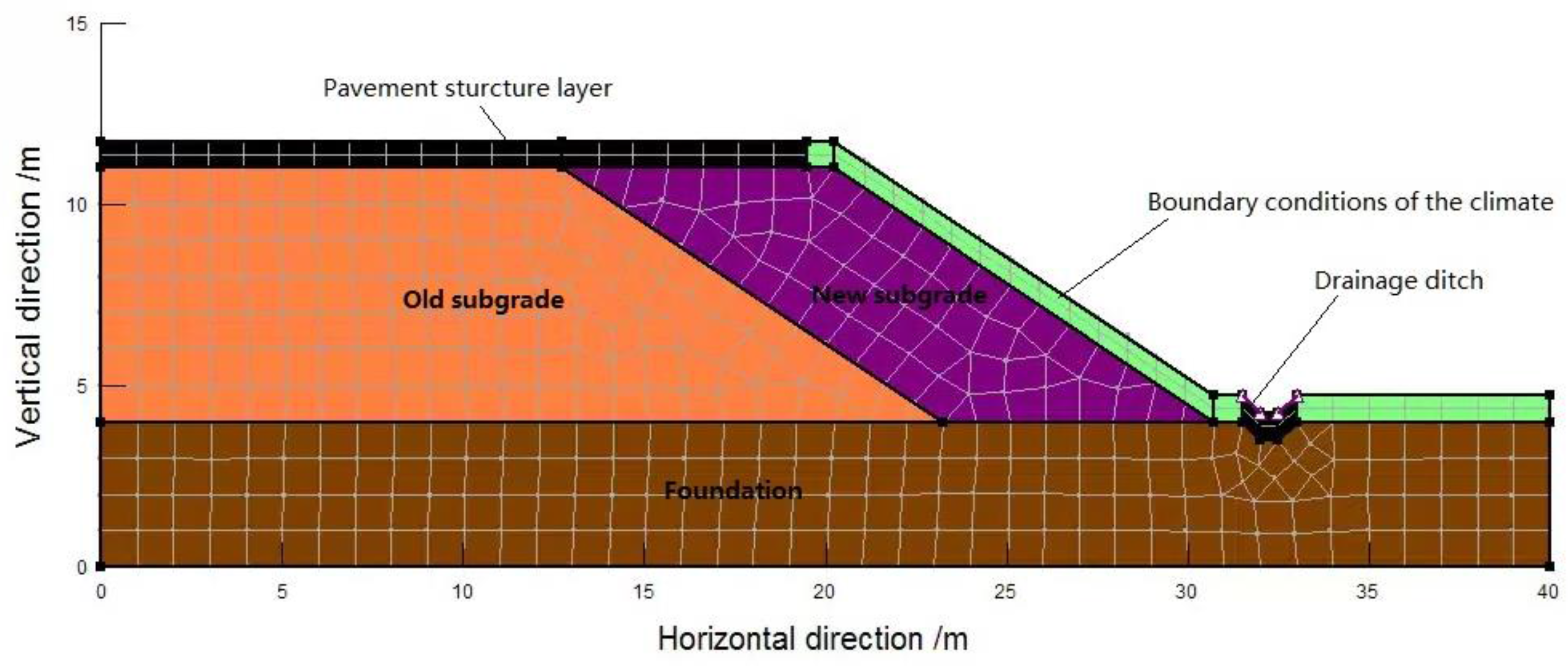

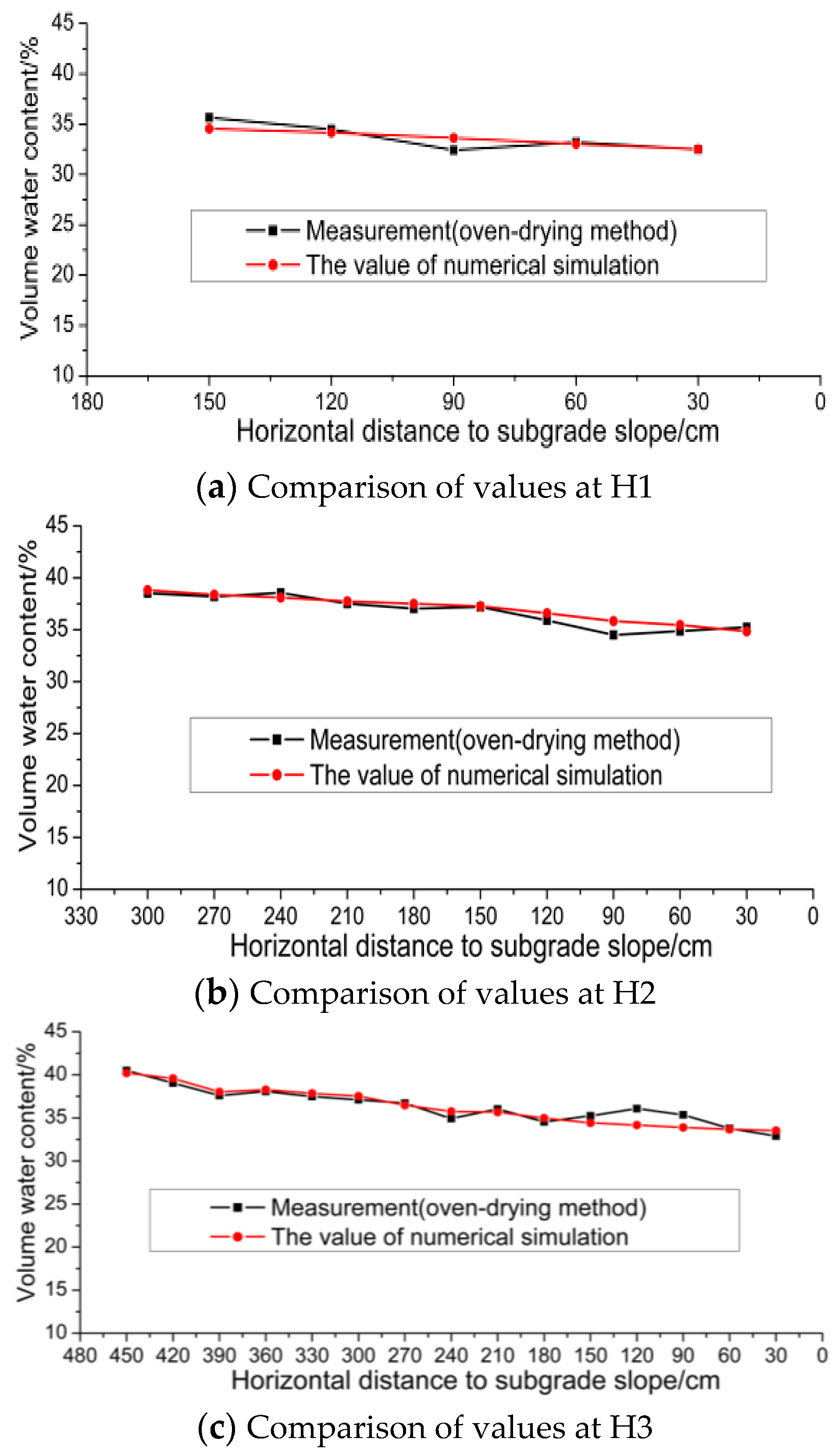

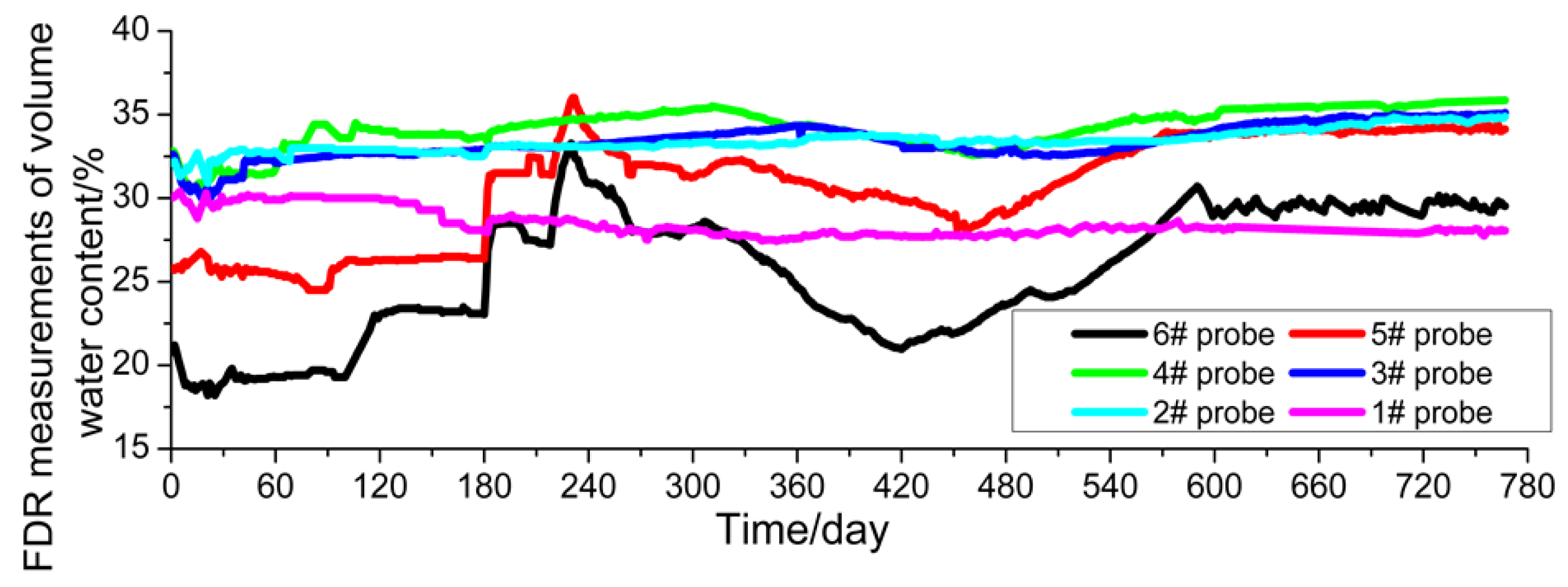
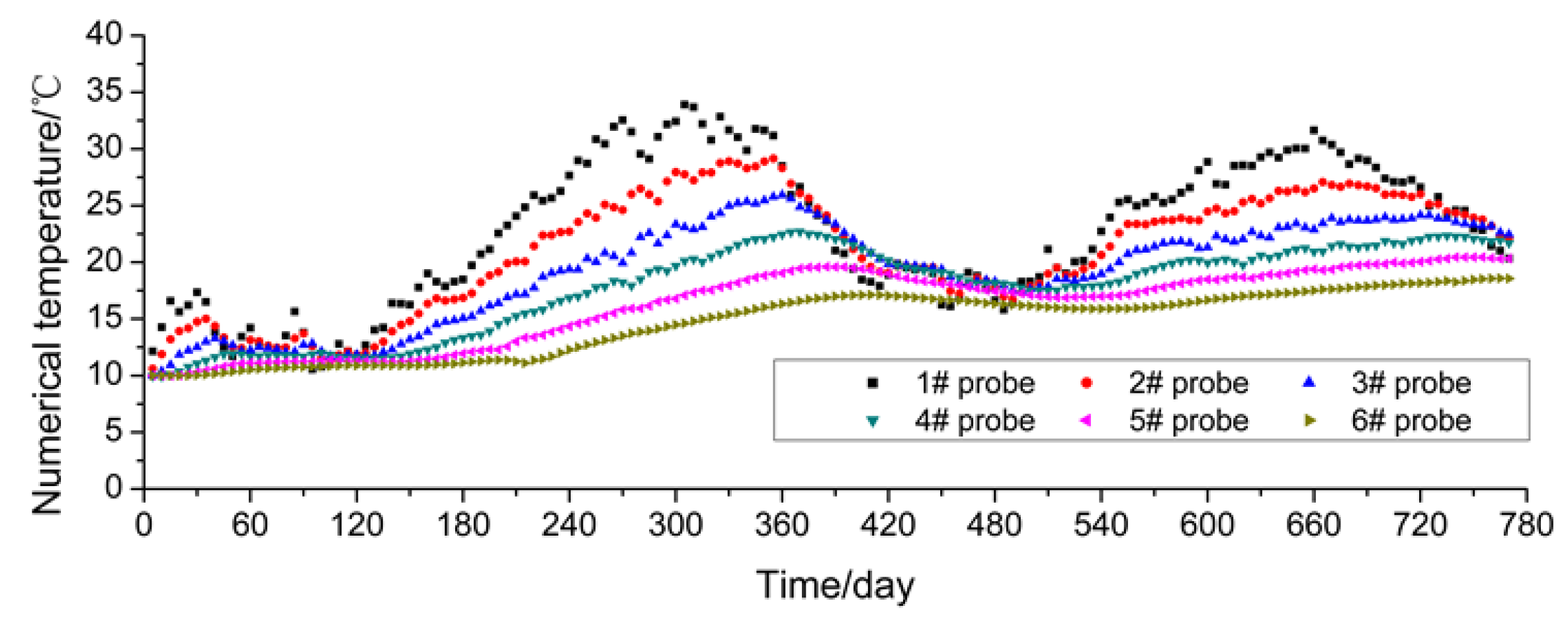
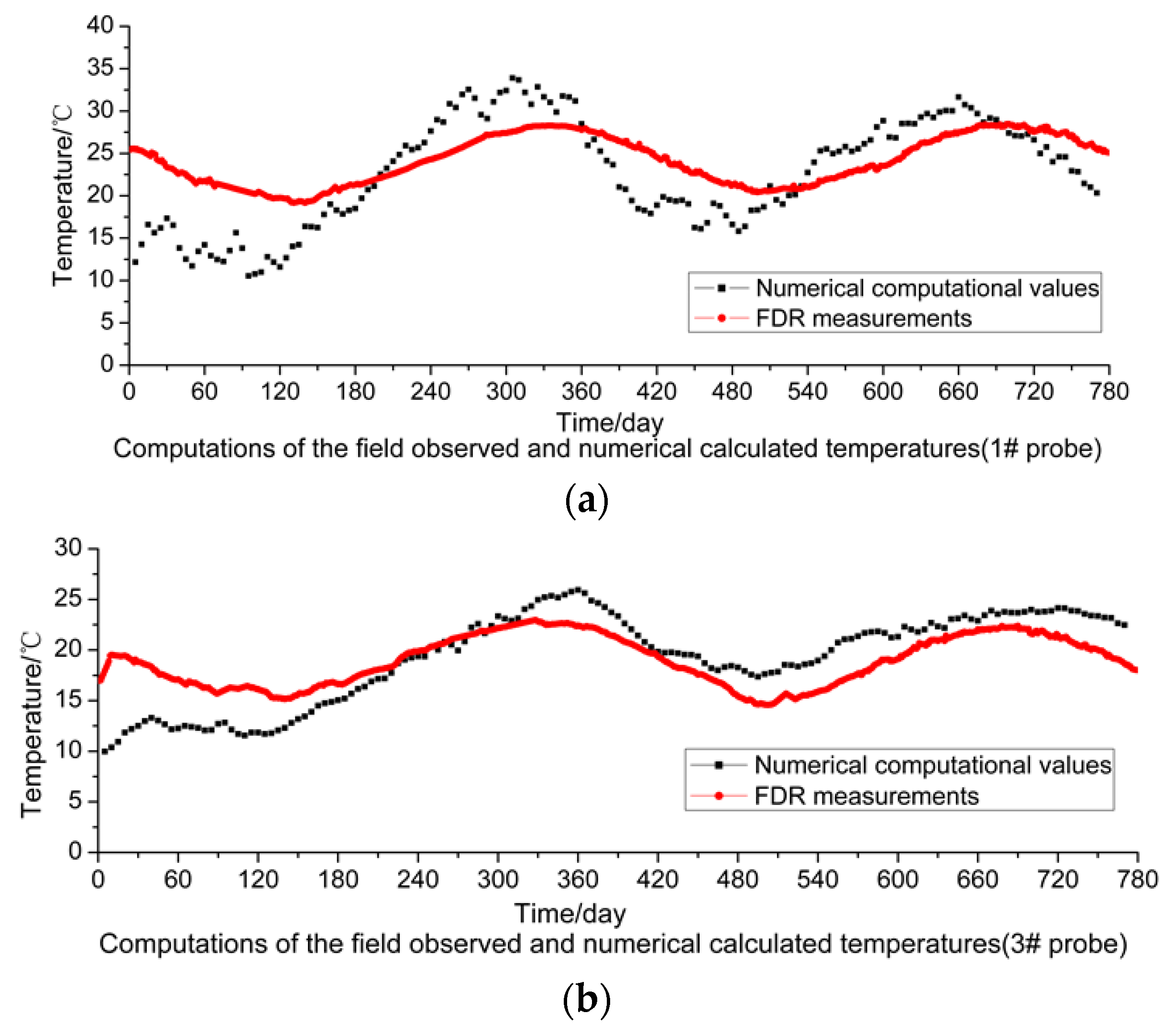
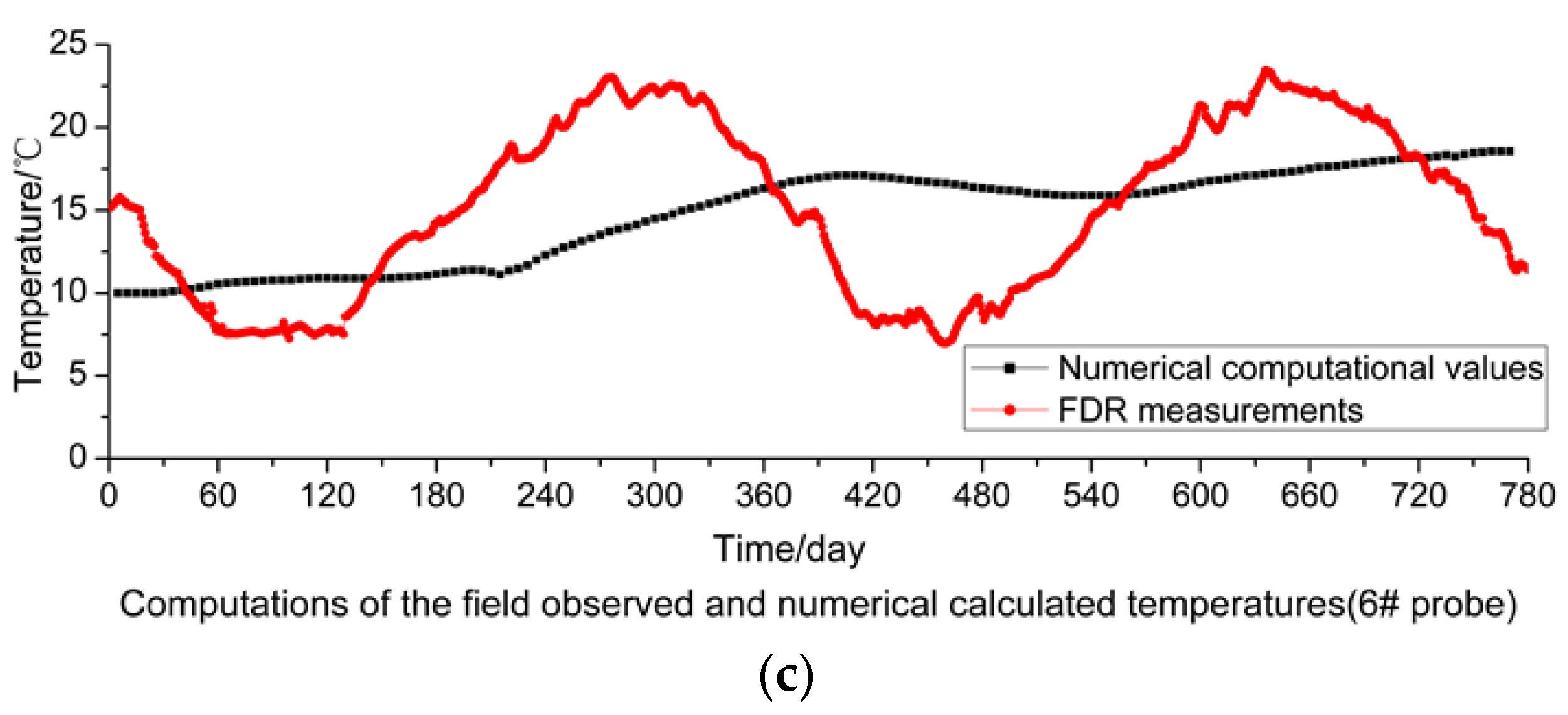
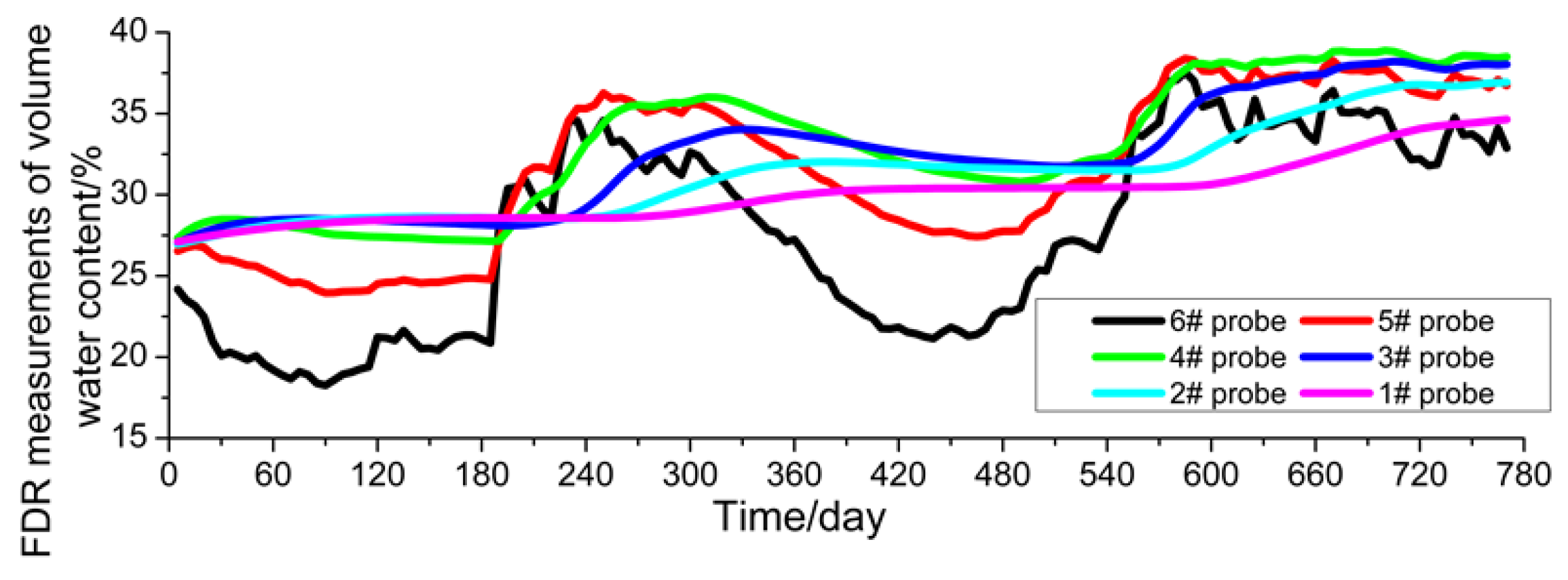
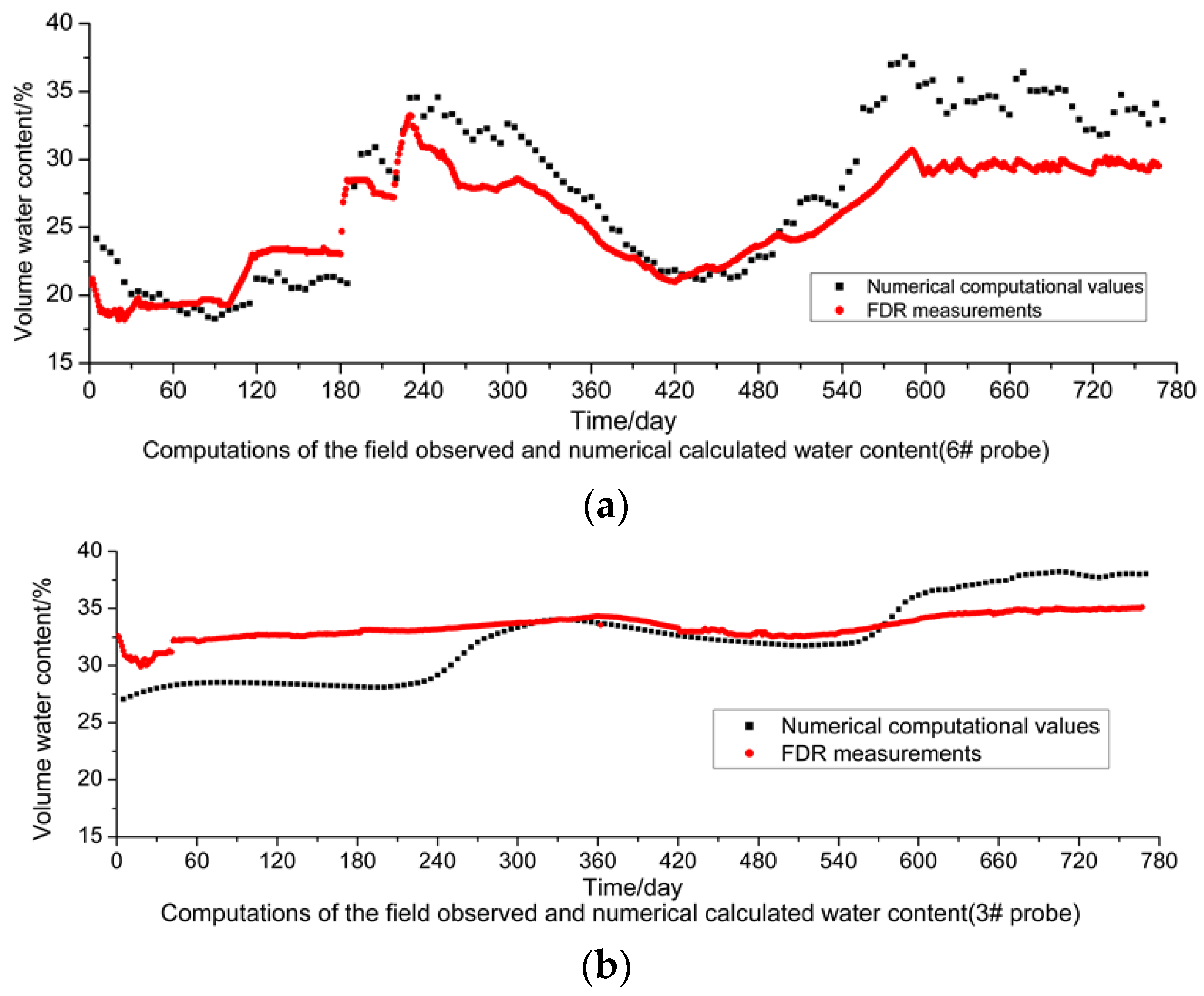
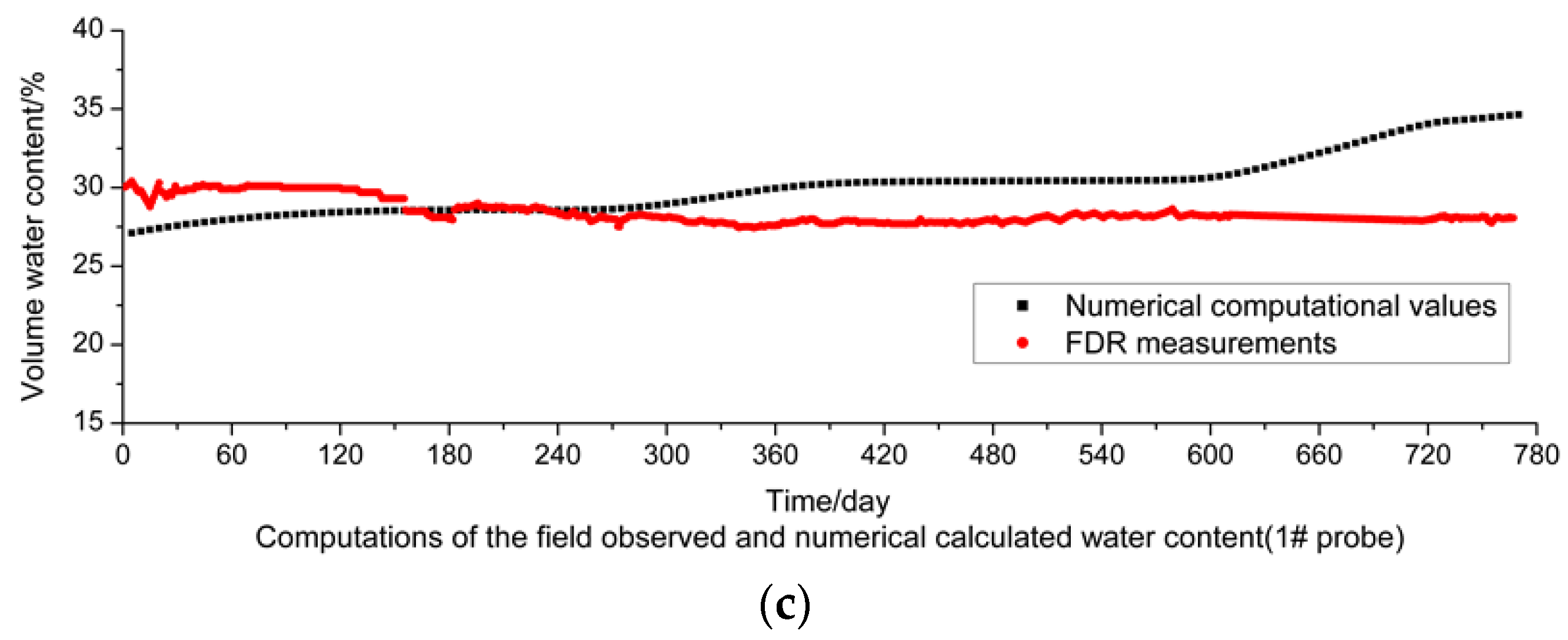
| Name | Function Relationship | Range of Application |
|---|---|---|
| Relationship between Soil volumetric water content and voltage | θ = 144.7 υ4 − 285.0 υ3 + 195.0 υ2 − 5.277 υ | Υ ≤ 1.005 V |
| θ = 500.0 υ − 452.5 | 1.005 V < υ ≤ 1.085 V | |
| θ (% vol) = 100 | 1.085 V < υ | |
| Relationship between soil temperature and voltage | T = 10.312 × (υ/100) − 81.25 | −30 °C~+50 °C |
| Parameter Category | Relevant Parameter | Symbol | Unit |
|---|---|---|---|
| Meteorological parameters | Daily average temperature | T | °C |
| Daily relative moisture | RH | % | |
| Daily relative wind speed | u | m/s | |
| Daily average rainfall | Pr | mm | |
| Hydraulic properties of soil | Saturated infiltration coefficient | kws | m/s |
| Soil-Water Characteristic Curve | SDSWCC | - | |
| Thermodynamic properties of soil | Heat conductivity coefficient | λt | - |
| Specific heat per unit volume | λv | J/(m3·°C) | |
| Physiological parameters of vegetation | Leaf area index | LAI | - |
| Root depth index | DR | m |
| Material | a | n | m | Sr | θs | R2 |
|---|---|---|---|---|---|---|
| Low Liquid-Limit Clay | 129.331 | 1.476 | 0.555 | 106 | 40.32% | 0.973 |
| Materials | Initial Degree of Saturation (%) | Infiltration Coefficients (m/s) | Soil Water Characteristic Curve Parameters | Thermal Conductivity Coefficient | Volumetric Heat Capacity (J·m−3) | ||
|---|---|---|---|---|---|---|---|
| a | n | m | |||||
| Foundation | Value of groundwater | 4.75 × 10−6 | 72.01 | 1.62 | 0.48 | 2.742 | 2.76 × 106 |
| low liquid-limit clay | 75 | 1.15 × 10−8 | 129.33 | 1.48 | 0.56 | 2.354 | 2.85 × 106 |
| Asphalt pavement | - | 1.0 × 10−14 | - | 1.010 | 1.98 × 106 | ||
© 2016 by the authors; licensee MDPI, Basel, Switzerland. This article is an open access article distributed under the terms and conditions of the Creative Commons Attribution (CC-BY) license (http://creativecommons.org/licenses/by/4.0/).
Share and Cite
Yao, Y.-S.; Zheng, J.-L.; Chen, Z.-S.; Zhang, J.-H.; Li, Y. Field Measurements and Numerical Simulations of Temperature and Moisture in Highway Engineering Using a Frequency Domain Reflectometry Sensor. Sensors 2016, 16, 857. https://doi.org/10.3390/s16060857
Yao Y-S, Zheng J-L, Chen Z-S, Zhang J-H, Li Y. Field Measurements and Numerical Simulations of Temperature and Moisture in Highway Engineering Using a Frequency Domain Reflectometry Sensor. Sensors. 2016; 16(6):857. https://doi.org/10.3390/s16060857
Chicago/Turabian StyleYao, Yong-Sheng, Jian-Long Zheng, Zeng-Shun Chen, Jun-Hui Zhang, and Yong Li. 2016. "Field Measurements and Numerical Simulations of Temperature and Moisture in Highway Engineering Using a Frequency Domain Reflectometry Sensor" Sensors 16, no. 6: 857. https://doi.org/10.3390/s16060857
APA StyleYao, Y.-S., Zheng, J.-L., Chen, Z.-S., Zhang, J.-H., & Li, Y. (2016). Field Measurements and Numerical Simulations of Temperature and Moisture in Highway Engineering Using a Frequency Domain Reflectometry Sensor. Sensors, 16(6), 857. https://doi.org/10.3390/s16060857







